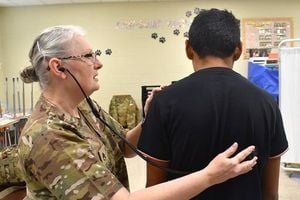Microglia, the resident immune cells of the central nervous system (CNS), play pivotal roles during neurological diseases, particularly brain arteriovenous malformations (bAVMs). A recent study published on February 1, 2025, highlights the varying states and immunogenic responses of these cells under conditions of Recombination signal binding protein for immunoglobulin kappa J region (Rbpj) deficiency, which is associated with vascular abnormalities.
The research, conducted using a mouse model, advocates for the significance of exploring microglial adaptations to chronic pathological changes brought on by bAVMs. The study elucidates how these alterations are not uniform across the brain, presenting distinct responses depending on specific regions, particularly the cortex and cerebellum.
During the examination of bAVM pathology, the authors noted marked increase in Ionized calcium-binding adapter molecule 1 (Iba1) expression within the Rbpj-deficient tissues, indicating microglial activation. This was accompanied by notable hypertrophy and hyperproliferation of Iba1 positive cells, reflecting substantial changes to the cellular properties of microglia as the disease progressed.
“Our findings demonstrate region-specific changes to CNS resident macrophages during Rbpj-deficient bAVM,” remarked the authors of the article. These results underpin the necessity of focusing on localized immune responses to develop targeted therapies for neurovascular anomalies.
Interestingly, the research indicates variances in macroglial profiles between the cortex and cerebellum. While cortical microglia exhibited profiles more reflective of pro-inflammatory responses, those from cerebellar regions faced changes suggestive of immunovigilance, preparing the cells for potential pathogen recognition. Such insights provide valuable clues for future research aimed at addressing the heterogeneous nature of CNS immune responses.
The methodologies employed included advanced imaging and gene expression analysis techniques, allowing for detailed comparisons of microglial structure and function across different brain regions. This thorough approach underscored the complexity of microglial behavior, moving beyond traditional classifications of pro-inflammatory and anti-inflammatory states.
Findings from this study are particularly relevant considering the significant clinical risks associated with human bAVMs, which have approximately 34% chance of rupture, leading to devastating medical emergencies like hemorrhagic strokes. The traditional view of microglial roles has evolved; researchers now advocate for appreciating their dynamic states as influenced by surrounding pathological conditions rather than fixed classifications.
"These observations suggest microglia and non-CNS resident macrophages may populate areas with the most vascular and neural tissue damage,” the authors articulated, emphasizing the response of these immune cells not only to local injury but also to broader neurovascular health.
This research shines light on the imperative need for additional studies targeting the role of CNS macrophages within the spectrum of neurodegenerative and neurovascular diseases. The insights generated here could inform future therapeutic strategies aimed at amelioration of CNS pathologies characterized by abnormal microvascular development.
Transitioning from classical perspectives of microglial functions to recognizing their nuanced behaviors across different brain regions will be key to advancing treatment protocols for conditions like bAVM. The need for continued investigation is pressing, particularly to understand how manipulating these immune responses might mitigate damage and improve patient outcomes.
Overall, the study offers significant contributions to the field of neuroimmunology, advocating for heightened awareness of the region-specific actions of CNS resident macrophages and their potential for personalized therapeutic applications.



